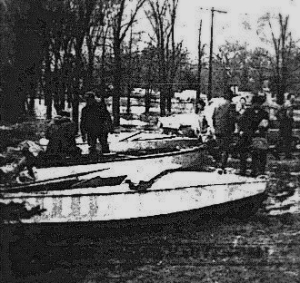Major floods were never a problem in Libertyville until 1938 (see previous post). After that, all was relatively dry in town until, within a two-year period in the early 1960s, Libertyville again was hit by major flooding. Although different areas throughout the village were affected by the flood waters, the damage seemed to be the worst at the relatively new 150-house subdivision of North Libertyville Estates. The Des Plaines River caused many problems within the subdivision, which was built right next to the banks of the river. In fact, the very construction of the subdivision was controversial, as the village hadn’t wanted the subdivision built so close to the Des Plaines River at all.

In the spring of 1960, conditions were right for a disaster for Northern Illinois and Northwest Indiana. The winter had seen plenty of snowfall and temperatures had remained cool throughout March. When the weather rapidly warmed up, snow started melting throughout the area causing widespread flooding. Melting water from the area was bad enough, but additional meltwater coming downstream compliments of the Des Plaines River made a bad situation even worse. Then on April 2, a heavy rain came down and an already high Des Plaines rose over 6 inches in the space of 8 hours.

Despite the quickly rising water, people in North Libertyville Estates had enough time to flee their homes and get to safety. Those who owned boats generously donated their services by taking people and property to higher ground. Some 100 households were displaced, sending people to hotels, friends’ homes or to the Red Cross. The Red Cross setup stations across the area, including at Libertyville’s Adler School. They provided food and a place to stay until it was safe to return home. Local citizens worked tirelessly to remove the water employing everything and anything at their disposal, from industrial equipment used to suck water out of people’s basements and crawlspaces to old-fashioned bucket brigades. Once the initial threat was dealt with, the Red Cross stayed on for a time to offer people assistance in dealing with the aftermath of caring for their damaged homes.

Two years later, in March of 1962, another flood occurred that was eerily similar to the previous one. Again the main culprit was meltwater and the main victim was North Libertyville Estates. The Red Cross again generously provided shelter and food for those in need. Roughly the same amount of people were affected, 100 to 120 households or about 250 people. One of the main differences between this flood and the one in 1962 was that there wasn’t any rain this time. Without additional rainwater added to the equation, people had more time to get themselves and their property out of harm’s way. On a positive note, people had learned from the previous flood and in 1962 were able to cope with the disaster much more efficiently. The most important result to come from the early 1960s disasters was the realization that something needed to be done to prevent further damage from future floods.

This wasn’t a new idea. For years, even before the 1938 flooding, citizens had raised their concerns about the frequency of flooding and pushed for something to be done about it. After the flood in 1962 Senator Everett Dirksen & Governor Otto Kerner both stated that some kind of plan needed to be formulated. The problem became “whose problem” was it? Since the main culprit was a moving body of water, could anyone upstream be held responsible? And if so, how far upstream? Was it as state issue (Illinois or Wisconsin?) or a federal one? The question of jurisdiction, as well as exactly how the problem should be handled, bogged the situation down for years—too many years, some would have said in the late 1980s when massive floods hit again. Finally, in 1997, the Army Corps of Engineers constructed a levee to hold off Des Plaines River flood waters from the North Libertyville Estates subdivision. Stay tuned for the final installment in the thrilling tale of Libertyville and her floods.
Sources
- “Estaters’ Sprits Are High.” Libertyville Independent, April 7, 1960, p. 1, 3.
- “Human Side of the Flood.” Libertyville Independent, April 7, 1960, p. 1, 4.
- “Lake County Maps Online.” Lake County Maps Online. Web. 30 June 2015. http://maps.lakecountyil.gov/mapsonline/
- “’Doing All We Can: Willer’.” Libertyville Independent, March 22, 1962, p. 1, 3.
- “Huxold Calls For Action.” Libertyville Independent, March 22, 1938, p. 1, 4.
- “Flood Did Not Reach 1960 Proportion.” Libertyville Independent, March 29, 1938, p. 1, 4.
- “Dirksen Said He’s Willing To Lend Aid.” Libertyville Independent, March 29, 1938, p. 1, 3.
Categories: Local History
